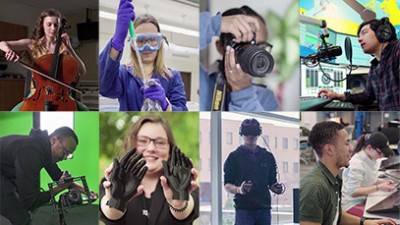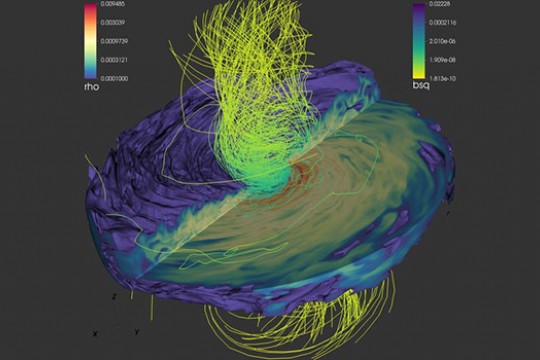News
Astrophysical Sciences and Technology Ph.D.
-
June 19, 2019
![Galaxy simulation]()
Did a Dwarf Galaxy Crash into the Milky Way?
Sky & Telescope reports that a recent study by RIT suggests the dwarf galaxy Antlia 2 had a long-ago run-in with our galaxy, rippling and warping its disk. But not everyone agrees with that scenario.
-
June 18, 2019
![Galaxy]()
Milky Way Collided with Dark-Matter Dominated Galaxy Less Than Billion Years Ago
Sci-News features new research, led by RIT, that shows the collision of the recently-discovered dwarf galaxy Antlia 2 with the Milky Way Galaxy hundreds of millions of years ago is responsible for ripples in the Milky Way’s outer gas disk.
-
April 23, 2019
![Researchers stand in front of gigantic observatory.]()
RIT researchers help conduct experiment to study how the first stars and galaxies formed
While many people flock to warm destinations for spring break, two RIT experimental cosmologists spent theirs 6,800 feet high on snow-covered Kitt Peak at the Arizona Radio Observatory. They were deploying an instrument to a 12-meter telescope for a project called the Tomographic Ionized-carbon Mapping Experiment (TIME), which aims to study the universe’s first stars and galaxies.
-
January 22, 2019
![Man in tan suit stands and types on keyboard of supercomputer]()
Professor Lousto recognized as outstanding physicist diversifying the field
The American Physical Society is recognizing RIT Professor Carlos Lousto for significant contributions to physics research and the advancement of underrepresented minority scientists.
-
January 21, 2019
![Graphic of blue and green view of space with pixelated mouse cursor]()
This Scientist Is Hunting for Planets That Orbit Dead Stars
Futurism features Jason Nordhaus, an NTID assistant professor of physics and a program faculty member in RIT’s astrophysical sciences and technology Ph.D. program.
-
January 9, 2019
![Professor in gray suit stands near window]()
Astrophysicist confirms theory about dying stars
A revolutionary technique developed by NTID astrophysicist Jason Nordhaus could allow for a better understanding of the fates of solar systems when their stars cease to shine.
-
January 3, 2019
![logo for RIT intersections: the RIT podcast.]()
Podcast: New Frontiers for Women in Astronomy
Intersections: The RIT Podcast, Ep. 6: Jeyhan Kartaltepe, assistant professor of physics and astronomy, and Brittany Vanderhoof, Ph.D. student in astrophysical sciences and technology, discuss their career paths, the opportunities and challenges for women in the sciences and their own efforts to be role models for future generations of scientists.
-
October 26, 2018
![Triana Almeyda holds her Ph.D. Dissertation Award and poses for a photo next to Twyla Cummings.]()
RIT alumni recognized for outstanding research on black holes
RIT’s Office for Graduate Education recently celebrated groundbreaking research on black holes by two alumni at the annual Graduate Alumni Awards reception. -
October 2, 2018
![Two black holes swirl around each other, nearly touching in the center of the image. The black holes are bright pink and fade to a dark blue or purple around the edges.]()
Model follows light to supermassive black holes
The hunt is on for orbiting pairs of supermassive black holes on the verge of collision. Researchers at RIT have built the first simulation that could lead scientists to them. -
September 7, 2018
![Male student with glasses dressed in suit.]()
Student leaders work to grow graduate culture
Yashar Seyed Vahedein, an engineering Ph.D. candidate, established the Doctoral Student Association (DSA) as a social and professional connection for RIT’s doctoral and prospective Ph.D. students. -
March 29, 2018
![Two people working on a astronomical imaging system.]()
Using cinema technology for space missions
RIT scientist Zoran Ninkov is developing and testing an astronomical imager inspired by an Oscar-award winning cinema projection system. The RIT astronomical imaging system is competing with other technologies for deployment on future NASA space missions for surveying star and galaxy clusters. -
February 14, 2018
![Magnetic field lines diagram.]()
New study advances multimessenger astrophysics
A new simulation of supermassive black holes, the behemoths at the centers of galaxies, uses a realistic scenario to predict the light signals emitted in the surrounding gas before the masses collide, said RIT researchers in a new paper published in the Astrophysical Journal Letters.





















